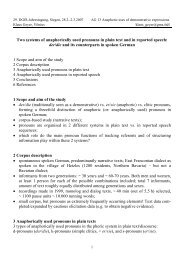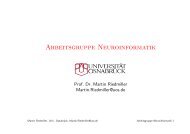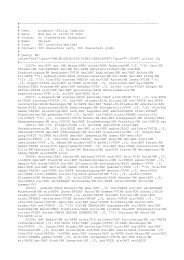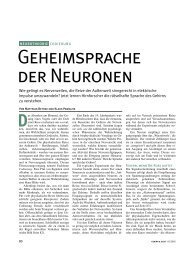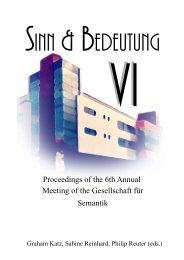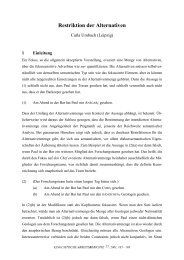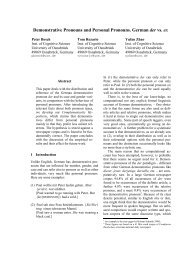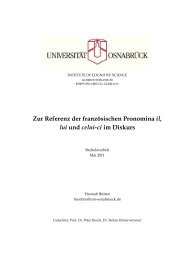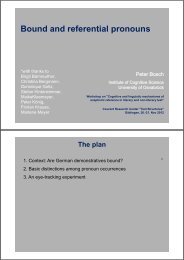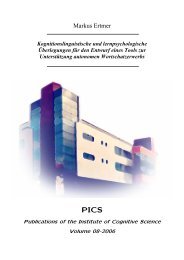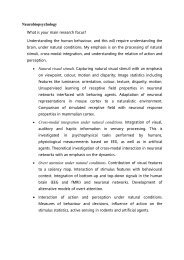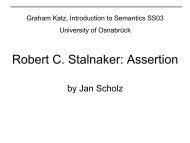Language Resources for a Network-based Dictionary
Language Resources for a Network-based Dictionary
Language Resources for a Network-based Dictionary
Create successful ePaper yourself
Turn your PDF publications into a flip-book with our unique Google optimized e-Paper software.
<strong>Language</strong> <strong>Resources</strong> <strong>for</strong> a <strong>Network</strong>-<strong>based</strong> <strong>Dictionary</strong><br />
Abstract<br />
In order to facilitate the use of a dictionary <strong>for</strong> language<br />
production and language learning we propose<br />
the construction of a new network-<strong>based</strong> electronic<br />
dictionary along the lines of Zock (2002). However,<br />
contrary to Zock who proposes just a paradigmatic<br />
network with in<strong>for</strong>mation about the various<br />
ways in which words are similar we would like to<br />
present several existing language resources (LRs)<br />
which will be integrated in such a network resulting<br />
in more linguistic levels than one with paradigmatically<br />
associated words. We argue that just as<br />
the mental lexicon exhibits various, possibly interwoven<br />
layers of networks, electronic LRs containing<br />
syntagmatic, morphological and phonological<br />
in<strong>for</strong>mation need to be integrated into an associative<br />
electronic dictionary.<br />
1 Introduction<br />
Traditional dictionaries are mainly used <strong>for</strong> language<br />
reception, even though they were also developed<br />
to be used <strong>for</strong> language production. However<br />
the <strong>for</strong>m-<strong>based</strong> structure following orthographic<br />
conventions which could also be called<br />
“one-dimensional”, makes it difficult to access the<br />
in<strong>for</strong>mation by meaning. There<strong>for</strong>e the usage of<br />
a traditional dictionary <strong>for</strong> text production is quite<br />
limited as opposed to, <strong>for</strong> example, a thesaurus.<br />
The main advantage of a thesaurus is the structuring<br />
<strong>based</strong> on the semantic relation between words in an<br />
entry. This allows <strong>for</strong> the availability of a different<br />
type of in<strong>for</strong>mation.<br />
There<strong>for</strong>e our proposal is to construct an electronic<br />
dictionary which has a network-like structure<br />
and whose content is drawn from various existing<br />
lexical resources. The dictionary will represent both<br />
paradigmatic in<strong>for</strong>mation - in<strong>for</strong>mation about the<br />
various ways in which words are similar - as well as<br />
syntagmatic in<strong>for</strong>mation - in<strong>for</strong>mation about the relationships<br />
among words that appear together. Additionally<br />
in<strong>for</strong>mation from other types of resources<br />
such as morphology and phonology will be inte-<br />
Veit Reuer<br />
Institute of Cognitive Science<br />
University of Osnabrück<br />
Germany<br />
vreuer@uos.de<br />
grated as they are also relevant in models of the<br />
mental lexicon. In these models “associations” between<br />
words are <strong>based</strong> not only on meaning but also<br />
on phonological or morphological properties of the<br />
connected words. Following Brown and McNeill<br />
(1966) and subsequent research people in the socalled<br />
“tip-of-the-tongue”-state (TOT-state) are able<br />
to clearly recall the properties of the missing word<br />
such as the number of syllables or the meaning, and<br />
can easily identify the target word when it is presented<br />
to them.<br />
chocolate<br />
herb birthmark<br />
berry <br />
<br />
<br />
hyper <br />
hyper<br />
hyper<br />
shortcake<br />
<br />
<br />
strawberry hypo<br />
<br />
<br />
cream<br />
garden strwb.<br />
<br />
<br />
hypo <br />
<br />
fruit<br />
hypo hypo<br />
wild strwb. <br />
jam<br />
<br />
<br />
beach strwb. Virginia Strwb.<br />
Figure 1: Example network with data from Word-<br />
Net (–) and Deutscher Wortschatz (=)<br />
Figure 1 exemplifies the visualization of a single<br />
node with related in<strong>for</strong>mation from two LRs 1 . Here<br />
a user would be able to find the term “shortcake”<br />
even if s/he only knows only one part, namely strawberries.<br />
2 A click on a neighbouring node should e.g.<br />
re-center the structure and hence allow the user to<br />
“explore” the network.<br />
As mentioned above the most obvious usage<br />
seems to be in language production where in<strong>for</strong>mation<br />
can be provided not only <strong>for</strong> words already<br />
activated in the mind of the language producer but<br />
also <strong>for</strong> alternatives, specifications or <strong>for</strong> words not<br />
directly accessible because of a TOT-state. This<br />
seems reasonable in light of the fact that speaker’s<br />
passively vocabularies are known to be larger than<br />
1 http://www.cogsci.princeton.edu/˜wn<br />
http://www.wortschatz.uni-leipzig.de<br />
2 LDOCE (1987) mentions “cream” and “jam” but not<br />
“shortcake” as part of the entry <strong>for</strong> “strawberry”. The entry <strong>for</strong><br />
“shortcake” however lists specifically “strawberry shortcake”.
their active vocabularies. The range of in<strong>for</strong>mation<br />
available of course depends on the material integrated<br />
into the dictionary from the various resources<br />
which are explored more closely below.<br />
A second area of application of such a dictionary<br />
is language learning. Apart from specifying<br />
paradigmatic in<strong>for</strong>mation which is usually also<br />
part of the definition of a lemma, syntagmatic in<strong>for</strong>mation<br />
representing collocations and cooccurrances<br />
is an important resource <strong>for</strong> language learners.<br />
Knowledge about collocations is a kind of linguistic<br />
knowledge which is language-specific and<br />
not systematically derivable making collocations especially<br />
difficult to learn.<br />
Even though there are some studies that compare<br />
the results from statistically computed association<br />
measures with word association norms from psycholinguistic<br />
experiments (Landauer et al., 1998;<br />
Rapp, 2002) there has not been any research on<br />
the usage of a digital, network-<strong>based</strong> dictionary reflecting<br />
the organisation of the mental lexicon to<br />
our knowledge. Apart from studies using so called<br />
Mind Maps or Concept Maps to visualize “world<br />
knowledge” 3 (Novak, 1998) nothing is known about<br />
the psycholinguistic aspects which need to be considered<br />
<strong>for</strong> the construction of a network-<strong>based</strong> dictionary.<br />
In the following section we will summarize the<br />
in<strong>for</strong>mation made available by the various LRs we<br />
plan to integrate into our system. The ideas presented<br />
here were developed in preparation of a<br />
project at the University of Osnabrück.<br />
2 <strong>Language</strong> <strong>Resources</strong><br />
Zock (2002) proposes the use of only one type of in<strong>for</strong>mation<br />
structure in his network, namely a type of<br />
semantic in<strong>for</strong>mation. There are, however, a number<br />
of other types of in<strong>for</strong>mation structures that may<br />
also be relevant <strong>for</strong> a user. Psychological experiments<br />
show that almost all levels of linguistic description<br />
reveal priming effects. Strong mental between<br />
words are <strong>based</strong> not only on a semantic relationship<br />
but also on morphological an phonological<br />
relationships. These types of relationships should<br />
also be included in a network <strong>based</strong> dictionary as<br />
well.<br />
A number of LRs that are suitable in this scenario<br />
already provide some sort of network-like structure<br />
possibly closely related to networks meaningful to<br />
a human user. All areas are large research fields of<br />
their own and we will there<strong>for</strong>e only touch upon a<br />
few aspects.<br />
3 The maps constitute a representation of the world rather<br />
than reflecting the mental lexicon.<br />
2.1 Manually Constructed <strong>Network</strong>s<br />
Manually constructed networks usually consist of<br />
paradigmatic in<strong>for</strong>mation since words of the same<br />
part-of-speech are related to each other. In ontologies<br />
usually only nouns are considered and are integrated<br />
into these in order to structure the knowledge<br />
to be covered.<br />
The main advantage of such networks, since they<br />
are hand-built, is the presumable correctness (if not<br />
completeness) of the content. Additionally, these<br />
semantic nets usually include typed relations between<br />
nodes, such as e.g. “hyperonymy” and “is a”<br />
and there<strong>for</strong>e provides additional in<strong>for</strong>mation <strong>for</strong> a<br />
user. It is safe to rely on the structure of a network<br />
coded by humans to a certain extend even if it has<br />
certain disadvantages, too. For example networks<br />
tend to be selective on the amount of data included,<br />
i.e. sometimes only one restricted area of knowledge<br />
is covered. Furthermore they include basically<br />
only paradigmatic in<strong>for</strong>mation with some exceptions.<br />
This however is only part of the greater<br />
structure of lexical networks.<br />
The most famous example is WordNet (Fellbaum,<br />
1998) <strong>for</strong> English – which has been visualized already<br />
at http://www.visualthesaurus.com – and its<br />
various sisters <strong>for</strong> other languages. It reflects a certain<br />
cognitive claim and was designed to be used<br />
in computational tasks such as word sense disambiguation.<br />
Furthermore ontologies may be used as a<br />
resource, because in ontologies usually single words<br />
or NPs are used to label the nodes in the network.<br />
An example is the “Universal Decimal Classification”<br />
4 which was originally designed to classify all<br />
printed and electronic publications in libraries with<br />
the help of some 60,000 classes. However one can<br />
also think of it as a knowledge representation system<br />
as the in<strong>for</strong>mation is coded in order to reflect<br />
the knowledge about the topics covered.<br />
2.2 Automatically Generated Paradigmatic<br />
<strong>Network</strong>s<br />
A common approach to the automatic generation of<br />
semantic networks is to use some <strong>for</strong>m of the so<br />
called vector-space-model in order to map semantically<br />
similar words closely together in vector space<br />
if they occur in similar contexts in a corpus (Manning<br />
and Schütze, 1999). One example, Latent Semantic<br />
Analysis (Landauer et al., 1998, LSA) has<br />
been accepted as a model of the mental lexicon and<br />
is even used by psycholinguists as a basis <strong>for</strong> the<br />
categorization and evaluation of test-items. The results<br />
from this line of research seem to describe not<br />
only relations between words but seem to provide<br />
4 http://www.udcc.org
the basis <strong>for</strong> a network which could be integrated<br />
into a network-<strong>based</strong> dictionary. A disadvantage of<br />
LSA is the positioning of polysemous words at a<br />
position between the two extremes, i.e. between the<br />
two senses which makes the approach worthless <strong>for</strong><br />
polysemous words in the data.<br />
There are several other approaches such as Ji<br />
and Ploux (2003) and the already mentioned Rapp<br />
(2002). Ji and Ploux also develop a statistics-<strong>based</strong><br />
method in order to determine so called “contexonyms”.<br />
This method allows one to determine different<br />
senses of a word as it connects to different<br />
clusters <strong>for</strong> the various senses, which can be seen<br />
as automatically derived SynSets as they are known<br />
from WordNet. Furthermore her group developed a<br />
visualization tool, that presents the results in a way<br />
unseen be<strong>for</strong>e. Even though they claim to have developed<br />
an “organisation model” of the mental lexicon<br />
only the restricted class of paradigmatic relations<br />
shows up in their calculations.<br />
Common to almost all the automatically derived<br />
semantic networks is the problem of the unknown<br />
relation between items as opposed to manually constructed<br />
networks. On the one hand a typed relation<br />
provides additional in<strong>for</strong>mation <strong>for</strong> a user about<br />
two connected nodes but on the other hand it seems<br />
questionable if a known relation would really help<br />
to actually infer the meaning of a connected node<br />
(contrary to Zock (2002)).<br />
2.3 Automatically Generated Syntagmatic<br />
<strong>Network</strong>s<br />
Substantial parts of the mental lexicon probably<br />
also consist of syntagmatic relations between words<br />
which are even more important <strong>for</strong> the interpretation<br />
of collocations. 5 The automatic extraction<br />
of collocations, i.e. syntagmatic relations between<br />
words, from large corpora has been an area of interest<br />
in recent years as it provides a basis <strong>for</strong> the automatic<br />
enrichment of electronic lexicons and also<br />
dictionaries. Usually attempts have been made at<br />
extracting verb-noun-, verb-PP- or adjective-nouncombinations.<br />
Noteworthy are the works by Krenn<br />
and Evert (2001) who have tried to compare the<br />
different lexical association measures used <strong>for</strong> the<br />
extraction of collocations. Even though most approaches<br />
are purely statistics-<strong>based</strong> and use little<br />
linguistic in<strong>for</strong>mation, there are a few cases where<br />
a parser was applied in order to enhance the recognition<br />
of collocations with the relevant words not<br />
5 We define collocations as a syntactically more or less fixed<br />
combination of words where the meaning of one word is usually<br />
altered so that a compositional construction of the meaning<br />
is prevented.<br />
being next to each other (Seretan et al., 2003).<br />
The data available from the collocation extraction<br />
research of course cannot be put together to<br />
give a complete and comprehensive network. However<br />
certain examples such as the German project<br />
“Deutscher Wortschatz” 6 and the visualization technique<br />
used there suggest a network like structure<br />
also in this area useful <strong>for</strong> example in the language<br />
learning scenario as mentioned above.<br />
2.4 Phonological/Morphological <strong>Network</strong>s<br />
Electronic lexica and rule systems <strong>for</strong> the phonological<br />
representation of words can be used <strong>for</strong> spellchecking<br />
as has been done e.g. in the Soundex approach<br />
(Mitton, 1996). In this approach a word not<br />
contained in the lexicon is mapped onto a simplified<br />
and reduced phonological representation and<br />
compared with the representations of words in the<br />
lexicon. The correct words coming close to the<br />
misspelled word on the basis of the comparison<br />
are then chosen as possible correction candidates.<br />
However this approach makes some drastic assumptions<br />
about the phonology of a language in order to<br />
keep the system simple. With a more elaborate set<br />
of rules describing the phonology of a language a<br />
more complex analysis is possible which even allows<br />
the determination of words that rhyme. 7 Setting<br />
a suitable threshold <strong>for</strong> some measure of similarity<br />
a network should evolve with phonologically<br />
similar words being connected with each other. A<br />
related approach to spelling correction is the use of<br />
so called “tries” <strong>for</strong> the efficient storage of lexical<br />
data (Oflazer, 1996). The calculation of a minimal<br />
editing distance between an unknown word and a<br />
word in a trie determines a possible correct candidate.<br />
Contrary to Zock (2002) who suggests this as an<br />
analysis step on its own we think that the phonological<br />
and morphological similarity can be exploited<br />
to <strong>for</strong>m yet another layer in a network-<strong>based</strong> dictionary.<br />
Zock’s example of the looked-<strong>for</strong> “relegate”<br />
may than be connected to “renegade” and “delegate”<br />
via a single link and thus found easily. Here<br />
again, probably only partial nets are created but they<br />
may nevertheless help a user looking <strong>for</strong> a certain<br />
word whose spelling s/he is not sure of.<br />
Finally there are even more types of LRs containing<br />
network-like structures which may contribute<br />
to a network-<strong>based</strong> dictionary. One example to be<br />
mentioned here is the content of machine-readable<br />
6 Note however that the use of the term “Kollokation” in this<br />
project is strictly <strong>based</strong> on statistics and has no relation to a<br />
collocation in a linguistic sense (see figure 1).<br />
7 Dissertation project of Tobias Thelen: personal communi-<br />
cation.
dictionaries. The words in definitions contained in<br />
the dictionary entries – especially <strong>for</strong> nouns – are<br />
usually on the one hand semantically connected to<br />
the lemma and on the other hand are mostly entries<br />
themselves which again may provide data <strong>for</strong> a network.<br />
In research in computational linguistics the<br />
relation between the lemma and the definition has<br />
been utilized especially <strong>for</strong> word sense disambiguation<br />
tasks and <strong>for</strong> the automatic enrichment of language<br />
processing systems (Ide and Véronis, 1994).<br />
3 Open Issues and Conclusion<br />
So far we have said nothing about two further important<br />
parts of such a dictionary: the representation<br />
and the visualization of the data. There are a number<br />
of questions which still need to be answered in<br />
order to build a comprehensive dictionary suitable<br />
<strong>for</strong> an evaluation. With respect to the representation<br />
two major questions seem to be the following.<br />
• As statistical methods <strong>for</strong> the analysis of corpora<br />
and <strong>for</strong> the extraction of frequent cooccurrance<br />
phenomena tend to use non-lemmatized<br />
data, the question is whether it makes sense<br />
to provide the user with the more specific data<br />
<strong>based</strong> on inflected material.<br />
• Secondly the question arises how to integrate<br />
different senses of a word into the representation,<br />
if the data provides <strong>for</strong> this in<strong>for</strong>mation<br />
(as WordNet does).<br />
With regard to visualization especially the dynamic<br />
aspects of the presentation need to be considered.<br />
There are various techniques that can be used to focus<br />
on parts of the network and suppress others in<br />
order to make the network-<strong>based</strong> dictionary manageable<br />
<strong>for</strong> a user which need to be evaluated in usability<br />
studies. Among these are hyperbolic views<br />
and so-called cone trees<br />
As we have shown a number of LRs, especially<br />
those including syntagmatic, morphological<br />
and phonological in<strong>for</strong>mation, provide suitable data<br />
to be included into a network-<strong>based</strong> dictionary. The<br />
data in these LRs either correspond to the presumed<br />
content of the mental lexicon or seem especially<br />
suited <strong>for</strong> the intended usage. One major property<br />
of the new type of dictionary proposed here<br />
is the disintegration of the macro- and the microstructure<br />
of a traditional dictionary because parts<br />
of the micro-structure (the definition of the entries)<br />
become part of the macro-structure (primary links<br />
to related nodes) of the new dictionary. Reflecting<br />
the structure of the mental lexicon this dictionary<br />
should allow new ways to access the lexical<br />
data and support language production and language<br />
learning.<br />
References<br />
R. Brown and D. McNeill. 1966. The ‘tip-of-thetongue’<br />
phenomenon. Journal of Verbal Learning<br />
and Verbal Behavior, 5:325–337.<br />
C. Fellbaum, editor. 1998. WordNet: an electronic<br />
lexical database. MIT Press, Cambridge, MA.<br />
N. Ide and J. Véronis. 1994. Machine readable dictionaries:<br />
What have we learned, where do we go.<br />
In Proceedings of the post-COLING94 international<br />
workshop on directions of lexical research,<br />
Beijing.<br />
H. Ji and S. Ploux. 2003. A mental lexicon organization<br />
model. In Proceedings of the Joint International<br />
Conference on Cognitive Science, pages<br />
240–245, Sydney.<br />
B. Krenn and S. Evert. 2001. Can we do better<br />
than frequency? A case study on extracting<br />
PP-verb collocations. In Proceedings of the<br />
ACL-Workshop on Collocations, pages 39–46,<br />
Toulouse.<br />
T. K. Landauer, P. W. Foltz, and D. Laham. 1998.<br />
An introduction to latent semantic analysis. Discourse<br />
Processes, 25:259–284.<br />
LDOCE. 1987. Longman <strong>Dictionary</strong> of Contemporary<br />
English. Langenscheidt, Berlin, 2. edition.<br />
C. D. Manning and H. Schütze. 1999. Foundations<br />
of Statistical Natural <strong>Language</strong> Processing. MIT<br />
Press, Cambridge, MA.<br />
R. Mitton. 1996. English Spelling and the Computer.<br />
Longman, London.<br />
J. D. Novak. 1998. Learning, Creating and Using<br />
Knowledge: Concept Maps as Facilitative Tools<br />
in Schools and Corporations. Erlbaum, Mahwah,<br />
NJ.<br />
K. Oflazer. 1996. Error-tolerant finite-state recognition<br />
with applications to morphological analysis<br />
and spelling correction. Computational Linguistics,<br />
22(1):73–89.<br />
R. Rapp. 2002. The computation of word associations:<br />
Comparing syntagmatic and paradigmatic<br />
approaches. In Proc. 19th Int. Conference on<br />
Computational Linguistics (COLING), Taipeh.<br />
V. Seretan, L. Nerima, and E. Wehrli. 2003. Extraction<br />
of multi-word collocations using syntactic<br />
bigram composition. In Proceedings of the International<br />
Conference on Recent Advances in NLP<br />
(RANLP-2003), Borovets, Bulgaria.<br />
M. Zock. 2002. Sorry, but what was your name<br />
again, or, how to overcome the tip-of-the tongue<br />
problem with the help of a computer? In Proceedings<br />
of the COLING-Workshop on Building<br />
and Using Semantic <strong>Network</strong>s, Taipeh.



